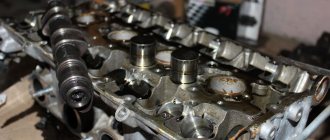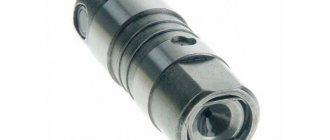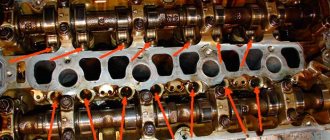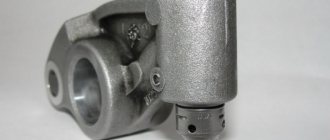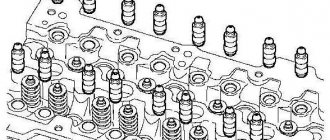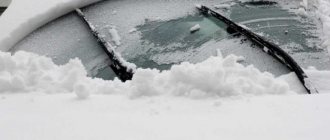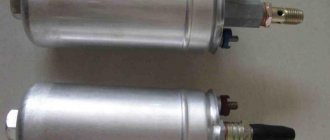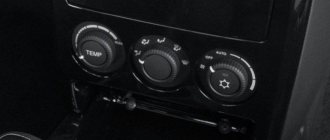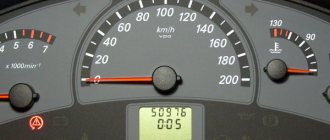Causes of knocking hydraulic compensators
- Engine knocking when starting. If the extraneous noise disappears a few seconds after starting the engine, this is not a sign of a malfunction.
- There is a knocking sound from hydraulic compensators on a cold and warm engine, the noise disappears when the speed increases. The check valve ball may be worn out and the hydraulic compensator will have to be replaced. It is also possible that the hydraulic compensator mechanism may become dirty; cleaning the parts will help.
- The knocking noise only occurs when the engine is warm. Wear and, as a consequence, the appearance of increased gaps between the plunger and the hydraulic compensator sleeve. You will have to change the hydraulic compensator.
- Engine knocking at high speeds. The cause may be too much or too little engine oil. Bring the engine oil level to normal. It is also possible that the oil receiver may be damaged, in which case the faulty parts should be replaced.
- The valves are constantly knocking. The reason may be a gap between the pusher and the camshaft cam. Cleaning or replacing faulty parts will help.
Knock is different, because the consequences are different.
How are these devices convenient? Because they perform their functions without requiring maintenance or special care.
You don’t have to think about them until you hear a certain, specific knocking sound from the hydraulic compensators.
Moreover, it can appear only at startup and disappear as it warms up, or it can continue all the time.
What happens when hydraulic compensators knock:
- the functioning of the plunger pair stops;
- the dynamic load on timing parts and components increases;
- fuel consumption increases;
- valve heads burn out with subsequent damage to the block head;
- noise occurs in the engine, making general diagnostics difficult;
- Acceleration dynamics deteriorate.
If you hear a knocking sound from the hydraulic compensators when cold, that is, immediately after starting and continues until the engine warms up, then the probable causes may be the following:
- The plunger valve allows oil to pass through when the engine is off.
- Narrowing of oil-conducting channels by pollutants. At the moment of start-up, the oil has a high viscosity and does not enter the plunger, which is why the hydraulic compensators knock when cold. When heated, the viscosity decreases and its penetrating ability increases.
- High oil viscosity. The knocking noise disappears as fluidity increases.
This phenomenon is not very critical, although it should not be ignored.
Often hydraulic valves knock only at the moment of start-up. This occurs because when stopping, some of the engine valves freeze in the open position and the plunger valve “bleeds” some oil. Well, what if the hydraulic compensators knock when they’re hot? Although the question is posed somewhat incorrectly. Let's figure out why the knocking appears when the engine starts and does not stop as it warms up. In this case, as in the previous one, there are several probable reasons:
- Poor quality oil initially or has not been changed for a long time. The knocking noise most often stops after an oil change.
- Malfunction of the hydraulic compensator itself.
- Oil filter dirty.
- The knocking of hydraulic compensators when hot occurs if the oil pump does not develop the required pressure.
There is another reason that, for some reason, appears on the Priora. A knocking sound in the compensators appears after replacing 5W40 oil with 0W40.
Basics of the design and operation of a hydraulic compensator
Configuration
The idea of automatic regulation of thermal clearances can be implemented in two versions: a conventional hydraulic pusher and a hydraulic support. The latter is used in gas distribution modules with rocker arms. On the Lada Priora in the sixteen-valve version, the intake and exhaust are equipped with individual camshafts. The optimal solution for this arrangement is the use of a hydraulic pusher.
Read also: What to do if you have no talent
The Priorov hydraulic compensator on the 126 engine consists of the following parts:
- A plunger pair, including a cylindrical cage and a piston with a ball valve.
- The outer housing is a pusher.
- System of grooves and holes for oil supply.
Principle of operation
The oil composition enters the internal cavity of the piston and, overcoming the resistance of the spring, pushes the ball away to fill the closed cylinder. When filling the liner, oil pushes the piston out and the hydraulic tappet rests against the cam. Next, the ball valve is locked and the assembly unit works like a regular pusher on motors with an adjustable valve mechanism.
Is it possible to drive with knocking hydraulic lifters?
Many drivers are interested in the question of whether it is possible to drive with knocking hydraulic compensators and what consequences this can lead to. Let's answer it right away - it is possible, but it is not advisable, since the car will be plagued by a number of problems . In particular:
- loss of power;
- loss of control elasticity (the car will respond worse to steering);
- unenvironmental friendliness (unhealthy exhaust plume from the rear);
- excessive fuel consumption may occur;
- increased vibration;
- additional noise under the hood.
Accordingly, during the operation of a faulty engine there is a chance to “finish off” it completely. Therefore, it is strictly not recommended to drive with faulty engine components. After all, sooner or later it will fail. And the sooner you start repair work, the cheaper and easier it will cost you.
Lada Priora is equipped with a VAZ 21126 engine with an automatic gas distribution mechanism adjustment system. The gap between the camshaft cam and the valve stem is selected by a hydraulic tappet, the successful operation of which is ensured by the engine oil system. The mechanism allows you to avoid making various types of adjustments in the timing belt, reduces fuel consumption and increases the efficiency of the power plant. Fundamentals of the design and operation of a hydraulic compensator
The hydraulic compensators on the Priora are knocking when hot
The normal operation of the vehicle's power plant is checked in a warm state. If the noise from the main engine occurs during “hot” conditions, the reasons for the knocking are similar to those that are relevant for cold operation with unique additions:
Read also: Black eyeliner and red lipstick
- Foaming of oil. This is usually caused by its low quality or violation of the required level - overflow.
- A consequence of overheating of the power plant - in this case, expansion of the main body seats occurs, which causes them to loosen.
Need advice on solving the problem of knocking hydraulic compensators on a Priora
Guys, the problem is this: the hydraulics were knocking on the Priora, I installed new ina brands, filled in new Lukoil synthetic oil 5w40, changed the timing belt, filter, rollers, but the knocking never stopped - the car runs cold like a diesel engine. There is no loss of power, the engine runs smoothly. MB anyone encountered this problem?
Maybe the problem is not in the hydraulics?
Read also: Hair breaks, what to do
and in what? That's why I'm asking if anyone has encountered such a problem
when hot the sound becomes much quieter, when the engine speed increases the sound disappears altogether, the knocking noise is only at idle
How did you check the hydraulics before installation?
in the seat I pressed on each hydraulic with a wooden handle - they all pressed very tightly
Who determined the knock and sentenced the hydraulics?
old hydraulics were generally easy to press with a finger
This is normal. You need to change it when they jam. You have been deceived.
so I personally bought new ones, it can’t be worse because of the new ones, in general, I don’t know what to do
Last edited by serikovk; 01.12.2016 at 10:35.
When I took the new ones, I somehow selected nine normal ones out of three sets. I quarreled with all the vendors.
Yes? Well, I don’t know, these new ones seemed to be alive, it feels easier to buy a new engine
For Priorka then? Pfff. Look for a normal service, they will tell you how much. And did you pump the hydraulics before installation?
They were already all covered in oil, so they installed it, then I found some literature that came with them - it was written there that to start the engine - hold the speed for 3500-4000 minutes for 5 minutes, then idle for a minute, then turn it off for a minute and start it. and so 5 times. These manipulations are of no use
Yes, take a new car, why?!
All are covered in oil, but empty. They needed to be pumped. Who fixes the engine and decides what to change??
the fact of the matter is that finances are minimal
how to pump them correctly?
Place in a bath of oil and press the plunger until the air comes out. Tell me, who sentenced them? Looks like you were scammed at the service center for repairs.
Yes, there is one repairman here, he does everything in the garage
Determining the source of the knock
It happens that a knock comes from the engine compartment. Only the driver may not immediately understand what exactly is the reason and who is the source of this noise. You should not immediately blame the valves, since they are not the only ones capable of making knocks.
It is quite difficult for a novice motorist, in the absence of experience in operating and repairing a car, to immediately determine what kind of breakdown or malfunction provoked the occurrence of noises and knocks. Sounds uncharacteristic of a working engine can come from bearings, belts, crankshafts, and the valves themselves. Moreover, in the latter case, we hear a fairly clear and easily audible sound, accompanied by a metallic knock. And it comes from the gas distribution mechanism.
Another characteristic feature of valve knock is that it does not stop, depending on the speed. That is, the knocking will persist when the engine is running at low speeds, and also when the driver, by pressing the gas pedal, increases the engine speed.
An ordinary driver is unlikely to be able to simply tell by ear that a valve has failed.
But still, self-diagnosis is quite possible. To do this you need to do the following:
- open the hood;
- unscrew the plug through which engine oil is poured;
- leave the engine running;
- listen; listen
- if the noise increases, the fault is in the valves;
- or take a stethoscope;
- apply the tool to the area where the noise is coming from;
- listen; listen
- draw appropriate conclusions.
This is just an approximate diagram of how to identify a breakdown and make a diagnosis practically in the field. Of course, it is often best to contact a car service center and undergo a comprehensive diagnosis. You can't joke with faulty valves.
As a consequence, you may encounter breakdown of the valves themselves, disruption of the timing belt, increased fuel and oil consumption, loss of power, and even failure of the engine itself.
The longer you ignore the problem, the more severe and expensive the consequences may end up being. If you hear a metallic knock while warming up or accelerating your car, go to a garage or service station. Don't delay diagnostics.
The knocking noise of the engine does not go away or appears after warming up
Much more dangerous is the knocking of hydraulic compensators, which appears as it warms up or only intensifies as the power unit reaches operating temperatures. In this case, the hydraulic compensators constantly knock at idle speed of a warm engine; the knock may be present under load, etc. The list of causes for this malfunction is wider than knocking noises on a cold internal combustion engine.
First, you need to make sure that it is the hydraulic compensators that are knocking when hot, since there are many reasons for knocking in the engine. To do this, you need to know how to identify a knocking hydraulic compensator. It is also important to be able to determine which hydraulic compensator is knocking, which will help more accurately localize the fault.
Note that the knocking of compensators has a characteristic sound. The pitch is high, the knock is loud, reminiscent of a metal ball striking another metal part, and is localized under the valve cover. Can be easily heard with a stethoscope. If the main valve knocks constantly, then it may soon become completely jammed or other breakdowns will occur. In such a situation, the engine needs repair; it is possible to replace the hydraulic compensators. In some cases, the seat of the hydraulic compensator is also broken. After the motor heats up, thermal expansion of the parts occurs, and the hydraulic fluid begins to “dangle” at the installation site and knock. A more accurate determination of a knocking main engine is possible after partially disassembling the motor and removing the cover.
As already mentioned, on a cold engine, contamination of the channels can cause knocking, after which the extraneous sound disappears as it warms up. In the case of a hot internal combustion engine, exactly the opposite happens, when, parallel to the increase in temperature, the deposits in the channel soften and shift, completely blocking the supply of lubricant to the main fluid chamber. In this case, it is also recommended to flush the hydraulic compensators and lubrication system, change the engine oil, or clean the engine after disassembling it.
The oil filter should be checked, which may be the cause of insufficient pressure in the lubrication system and, as a result, knocking of the engine when hot. If there is insufficient pressure in the hydraulic compensators, an air lock is created. The oil level in the engine also deserves special attention, which should not be lower or higher than normal (oil overflow into the engine). It should be noted that when cold, at low speeds and problems with the oil level, the HA may not knock. After the engine warms up, the amount of air in the oil increases and a knocking sound from the hydraulic compensators appears, as the oil and air become a compressible mixture. It is also advisable to check the operation of the oil pump and measure the pressure in the lubrication system if problems with the hydraulic fluid appear on a hot engine.
How to eliminate the knocking of hydraulic pushers on Lada Priora
Timely and high-quality maintenance of the engine oil system is the key to flawless operation of the hydraulic compensator mechanism. After all, the unit is designed for use throughout the entire resource of the power plant.
Use of recommended lubricant
When the hydraulic pushers just start knocking, the manufacturer recommends changing the lubricant to a proven option. Therefore, when the question arises of what kind of oil to pour in principle, it is worth analyzing reviews to determine the acceptability of a certain model of oil product for hydraulic compensators.
Of course, the best choice for Lada Priora will be the composition recommended by the manufacturer, specified in the instruction manual. However, not all current popular products are included in the list.
An analysis of opinions shows that, indeed, with the universal viscosity of 10W-40 or 5W-40 specified by the factory, not every oil is suitable. For example, Shell Helix Ultra 5W-40 causes knocking already at 15,000 km, while on Liqui Moly Optimal Synth 5W-40 the hydraulics are silent even at 80,000 km.
Reviews show that it is optimal to choose the following lubricants:
- Total Quartz 9000 Energy 5W-40.
- Mobil Ultra 10W-40.
- Wagner Windigo 10W-40.
Flushing
Many owners, in advanced cases, resort to general engine flushing. However, the effectiveness of such an event in the fight against knocking GCs is low. This is explained by poor oil pumpability in the area of the hydraulic pusher chambers.
If changing the lubricant does not help, the best solution is to remove the cylinder head cover and find which hydraulic compensators on the Lada Priora 16-valve engine are knocking and determine the reason for this. Defective parts are identified by diagnosing running resistance with a wooden wedge. A fast movement speed in comparison with other hydraulic supports indicates wear of the hydraulic module, the presence of a constant gap indicates its coking.
Attention! The wooden wedge must be pressed against the non-working surface of the cams.
Effective removal of carbon deposits inside the cylinders is their local washing. Worn assembly modules cannot be repaired.
Additives
Additive compounds help delay identifying the causes and cleaning the timing belt. There are several products available in the market. The most popular products are from Liqui Moly and XADO. The effectiveness of substances depends on the specific case. Fans of motor additives often equate this class of chemistry with a waste of money.
Everything should be nearby, don’t start without preparation
Lada Priora can serve as an example to consider the replacement process. To avoid unpleasant surprises, any work must be planned and everything necessary must be prepared. In our case we will need:
- Gasket Maker - sealant (anaerobic);
- camshaft plugs and seals;
- 16 INA compensators.
Let's start by disconnecting the battery minus. Then we dismantle the air filter, throttle cables, wires that will interfere with manipulation, injector ignition coils and intake manifold.
Replacing hydraulic compensators on a Priora is complicated by the fact that the manifold mounting bolt is located under the generator.
To get to the hydraulic compensators:
- The generator belt is removed, the generator itself is freed from the mounting bolts and carefully moved to the radiator. Using a wrench with a rotary head, the manifold mounting bolt is unscrewed.
- The ramp with nozzles is dismantled and the air conditioning pipes are disconnected (if equipped).
- The collector is dismantled. First, we lift its left edge and then the entire part, and then we move it to the left.
- The valve cover is removed using a screwdriver inserted into the technological grooves.
- Next, the timing belt is removed, the pulleys, camshaft bed and the shafts themselves are dismantled.
Procedure for replacing hydraulic compensators
Replacing this part with a new one is a simple procedure that you can do yourself; the make of the car in this case is not so important, since the design of the engine and the principle of operation are similar for all power units. The only difference is that when replacing the compensator on some models, the cylinder head cover gasket must also be changed. But, in general, the principle of replacement is the same, so you should consider replacing this part as a whole.
- Remove the valve cover.
- Remove the sprocket from the camshaft. This is done using wire. You just need to hook the part and lift it up.
- Check the tensioner and damper. If they are too worn out, they should be replaced with new ones.
- Remove the fasteners from the crankshaft and remove the bed.
- Remove the rockers and place them in a certain sequence. You can arrange them by number to avoid confusion.
- Remove the expansion joints one by one. When dismantling different parts you will have to apply different forces. This can be explained by vibration when driving. Hydraulic compensators are also located by numbers if they are planned to be cleaned and diagnosed.
- Rinse and clean the oil pipes and their installation sites.
- Screw the hydraulic compensators into place. Care should be taken during installation, as applying great force may damage the part. Therefore, it is advisable to use a wrench with a dynamometer.
- After installation, you should install the removed parts according to the numbers reverse to removal.
- It is imperative to secure the valves in place with a wide screwdriver.
Dismantled valves can be restored by washing them, but most often after replacement, no one washes the old parts.
This procedure is completely similar to replacing valves on a Niva Chevrolet. Other cars have minor differences. If you do not have sufficient skills or are not confident in your actions, it is recommended to contact specialized workshops.
If you are the owner of a car with n52 hydraulic compensators, then to remove extraneous sounds you just need to replace the oil with a more viscous one, for example 5W-40 oil. Such a replacement can correct the problem if the oil was to blame. If you drive your car too slowly, it will also ruin your car's engine. It is necessary to follow this commandment: slow acceleration with slow deceleration. This will help preserve the engine and also reduce fuel consumption.
Do-it-yourself replacement of hydraulic compensators on a Priora 16 valves:
Assembly nuances
After replacing 16 hydraulic compensators, everything must be restored to its original form. The most important operations in order:
- We clean and degrease the camshafts and seats of the bed and valve cover, both on the parts and on the engine.
- We change the seals, plugs and put both shafts in place. The inlet has a special belt, which is not present on the outlet. This is its distinctive feature.
- Apply Gasket sealant to the mounting location of the camshaft bed and mount it (no gasket required).
- We treat the fit for the valve cover with sealant and mount it (no gasket required).
- We install injectors, condenser tubes, mount the manifold, generator, its belt, pulleys and timing belt.
- We restore the operation of the throttle valve, filter and connect all the wires.
Replacing hydraulic lifters sometimes results in the engine not starting due to lack of compression. As a rule, hydraulic valves are installed oil-filled and it may happen that due to the incompressibility of compensators, some valves will be open. To avoid this, it is necessary to tighten them with a clamp before installation.
If, when starting the 16-valve Priora engine, you hear knocking noises in the engine compartment, which will disappear as the power plant warms up, then you should check the hydraulic compensators (HC). When every start of a cold engine is accompanied by a knocking sound, this is a clear sign of a worn hydraulic compensator. We will tell you how to replace expansion joints yourself. We will also look at a component such as the cylinder head check valve, which can also cause defects in the operation of compensators.
Hydraulic compensators are sensitive to the quality of lubricant. If mechanical impurities are present in the oil, the part may fail ahead of schedule. Faulty hydraulic compensators cannot be repaired. After installing new compensators, you may be upset by the knocking of the remaining main valves - this is normal, but not for a long time.
Hydraulic compensator operating principle and design
The hydraulic compensator is a small cylinder, inside of which there is a spring and a pair of even smaller cylinders - plungers, as well as a check valve. The operating principle of the engine is such that it achieves maximum efficiency when the chamber contains a “clean” mixture - exclusively fuel and air.
When gases remain there after one cycle, the mixture becomes increasingly less pure and the engine produces less power. In order for gases to leave the chamber in time, the operation of the valves must be harmonious. There are hydraulics for this - they constantly adjust the position of the valves. And oil enhances their work and helps fight friction.
The oil enters a small gap under the plunger, presses on it, and after that the pusher exerts force on the valve. When at rest (during the so-called “break” when the cam moves), the pusher is constantly in contact with the camshaft cam, which is ready at any moment to move it down so that the valves open even more.
On Priora, the knocking sound of hydraulic compensators appears when the trajectory of their movement changes. That is, when they have to change the position of the valve, they move “crookedly”, and their efficiency approaches zero. There can be several reasons for problems with hydraulics and valves. Diagnostics may lead to the discovery of other faults.
What to do if hydraulic lifters are knocking on LADA cars
Have you encountered any unusual engine noise? Perhaps it's the hydraulic compensators knocking. This problem occurs most often on Priora, but knocking also appears on other Lada cars (for example, Granta, Kalina, Largus Niva 4x4, Vesta or XRAY). Let's figure out why such a knock appears in the engine and how to deal with it.
The hydraulic compensator (also known as hydraulic pusher) is a cylindrical shape that is located between the camshaft and the valves. They perform two functions: transmitting force from the camshaft to the valves and eliminating gaps in their drive.
Diagram of operation of the hydraulic pusher in the valve mechanism of the VAZ-21126 engine: 1 – valve; 2 – check valve spring; 3 – check valve; 4 – cylinder head; 5 – camshaft cam; 6 – pusher; 7 – plunger; 8 – plunger spring; 9 – sleeve; 10 – check valve body; A, B – hydraulic pusher cavities; B – oil channel.
What's inside
The gap is adjusted automatically. The operating principle of hydraulic compensators is based on a negligible oil compression ratio. At the moment when the holes (made specifically for the passage of lubricant) in the cylinder head and the compensator body coincide, oil will flow into it. Next, it will enter the upper chamber of the plunger through the groove, and then, through the opened ball valve, it will fill the lower chamber.
Since the oil is supplied under pressure, the plunger is squeezed out, pushing the compensator body upward until it rests against the cam. The shaft cam, turning, presses on the hydraulic compensator, which goes down. The holes close, the oil flow stops and the ball valve closes.
The oil has the property of incompressibility, so the force of the timing shaft cam is transmitted through the hydraulic compensator to the automobile valve. It opens. Further movement of the cam causes the valve spring to push it up and it closes.
Some of the oil may leak through the plunger ball seat in the opposite direction, increasing the gap, but in the next cycle, when the oil pipe holes align again, the oil volume will be replenished and the gap will return to normal.
Typical faults
Before examining the removed hydraulic compensator, you need to identify the non-functioning element. Compensators are located on the valves, so their number is equal to the number of valves provided on the engine. The check can be done without removing the camshaft. But first you need to understand why even new elements fail. There are 4 main faults.
- The gap provided between the plunger itself and its bushing increases. As a result, oil will begin to leak. The compensator will not be able, so to speak, to select thermal gaps;
- The valve does not close properly. This happens rarely, but it should not be ruled out. Because of this, the required pressure cannot be created between the plunger and the bushing;
- Jamming of the plunger pair. The way the sleeve works is that it should move freely relative to the installed plunger. If this freedom is not there, hello jamming;
- Blockages. Oil channels become dirty. Therefore, hydraulic compensators (HC) cannot work.
Consequences
Incorrect operation of hydraulic pushers can lead to the following problems:
- reduction in compression and engine power;
- deterioration of its launch;
- burnout of valve plates and seats;
- an increase in shock load on vehicle components and parts, which will lead to their rapid failure;
- increase in fuel consumption.
Checking the cylinder head check valve
When disassembling the pusher, you will come across a cylinder head check valve, which contains a ball with a spring. Inspect the cylinder head check valve; if these elements are damaged, then only replacing the pusher will help. The cylinder head check valve along with its components can be replaced entirely, but these parts cannot be found in every car store. They are not in demand, as it rarely fails.
When you inspect the check valve, check whether it is dry or not. If the hydraulic compensator is working properly, then the check valve should be in oil. You can pour lubricant into it and see why the oil leaves.
Inlet
It happens that this hole can become clogged, but it is intended for lubricant. How does the compensator continue to work as the engine warms up? The lubricant heats up, then the gap expands. The debris that covered the holes disappears, and oil begins to flow in quantities close to normal. However, when cooling, various viscous particles will clog the hole again, which will lead to poor lubricant access. This is why hydraulic compensators knock when cold.
To fix the problem, you can try changing the oil.
Knocking after replacement
Usually new parts don't knock.
If you still hear sounds, then this is a manufacturing defect or a problem with the valves. In order to perform an accurate diagnosis and make sure that there is nothing wrong with the valves, it is necessary to check their fastenings. There is a possibility that the parts did not shrink as required. We simply tighten them and thereby remove the knock of the hydraulic compensator.
How to identify a faulty hydraulic compensator
These parts may rattle when starting a cold engine, and then continue to make noise even when the engine warms up. Knowing about this malfunction, follow these steps to identify faulty Priora hydraulic pushers:
- Check the main valve ball valve. If it is worn out, then nothing can be done - the hydraulic valve will have to be changed and a new part installed in its place.
- The internal cavity of the pusher is contaminated with used grease or oil. If the cases are not critical, you can wash the hydraulics and then coat everything inside with a good oil composition.
- A couple of plungers are worn out - these are two small cylinders. The part cannot be repaired, so it will also have to be replaced.
These signs appear when the hydraulic valves knock while the engine is cold, as well as after it has warmed up, but they quiet down at high speeds. There is another way that will help identify faulty hydraulic pushers. It touches the spring - it is responsible for ensuring that the small parts return to their place whenever the valve needs to be returned back, closing the hole.
By the way, let’s talk about why Priora hydraulics can knock after repair work:
- If new parts make a sound, they are still falling into place - after a couple of engine starts this sound will not be there.
- If the knocking noise appears after changing the oil, the reason is poor-quality oil or a bad/worn out filter.
- Finally, after the car has been left alone for a long time, this piercing sound may also appear. Over time it will disappear. It's just that the oil has drained from the working chambers, and they need to be filled before starting everyday operation without knocking, as well as other signs of malfunctions that can be scary.
Realizing the severity of the work that the engine does in the cold, we can talk in detail about the reasons why the hydraulic pushers of a cold sixteen-valve Priora engine knock:
- The engine oil life is coming to an end. The oil is of poor quality. The oil is contaminated with engine operating products.
- The viscosity of the engine oil is not suitable for the engine. If it is too soft, the hydraulics will literally “break out” of their positions, which will damage their springs.
- If the oil is too thick, the hydraulic boosters will physically be unable to push the valve.
- The oil system is clogged. If the cross-section through which the valve passes is reduced, the pressure inside the hydraulic tappet decreases and it produces less power during operation.
- The main oil line does not support high pressure. This can be recognized by the burning light indicating the oil level on the dashboard.
- The plunger inside the main valve is jammed. This can happen due to carbon deposits accumulated inside.
- The plunger is worn out. If the check valve leaks, there can be no talk of any high pressure that the hydraulic fluid exerts on the valve.
When the engine temperature has gradually risen to operating temperature, the knocking noise may remain. On the contrary, it can suddenly appear. The cause could be any problem typical of knocking on a cold Priora engine. But due to the specifics, two more reasons can be named that cause the knocking of hydraulic pushers in warm Priora engines:
- High or low oil level. When there is too much oil, it doesn't provide room to work. If it is too small, there will not be enough pressure to push the valve.
- The hydraulic wells have expanded due to an overheated engine. Small parts will “walk” in them, and then even go down with a figure eight. Because of this, all the force that they could exert on the valve will be extinguished. Cool down the engine.
You need to check all hydraulic compensators using this method: press it with a screwdriver. The cam of the element should face the pusher with the back of its head. In good condition, the hydraulic pusher will press with obvious force. Otherwise, the experimental element is broken.
There is another method. One by one, set all the camshaft cams to the upper position and check whether there are gaps between them and the pushers. While pushing down the element, visually compare the speed of its movement relative to the others. If a gap is detected or the rotation speed is higher than normal, disassemble the hydraulic compensator and clean it of dirt. If this does not help, replace it.
